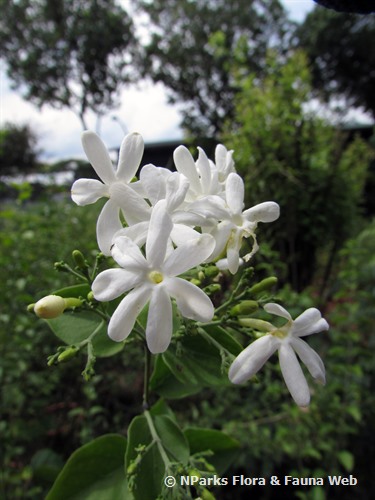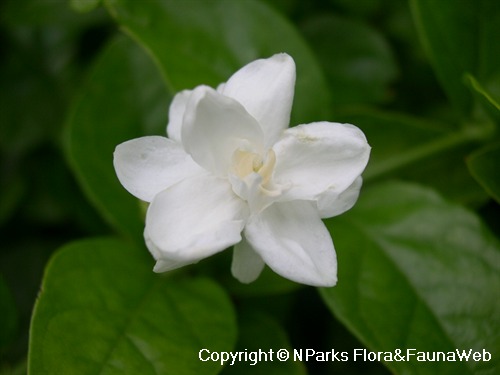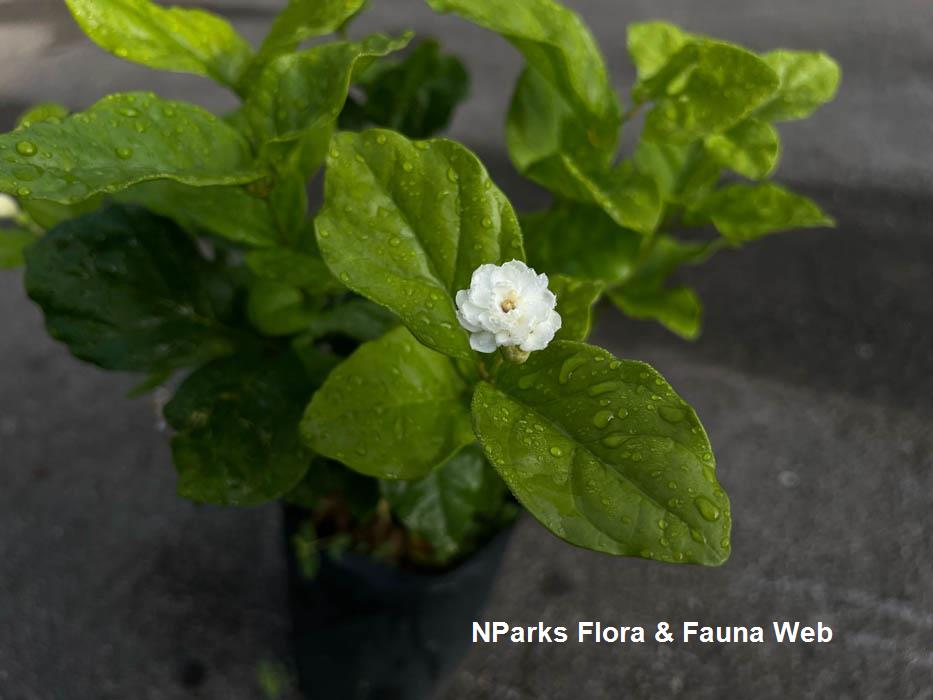
Name
Classifications and Characteristics
| Plant Division | Angiosperms (Flowering Seed Plants) (Dicotyledon) |
|---|---|
| Plant Growth Form | Climber, Shrub |
| Lifespan (in Singapore) | Perennial |
| Mode of Nutrition | Autotrophic |
Biogeography
| Native Distribution | India, North West Himalaya and Nepal to Sri Lanka, mainly in drier regions. |
|---|---|
| Native Habitat | Terrestrial |
| Preferred Climate Zone | Tropical |
Description and Ethnobotany
| Growth Form | It is an evergreen climber. |
|---|---|
| Foliage | Leaves are oppositely arranged along the stem, trifoliolate (sometimes simple), grey pubescent (hairy), petioled. Leaflets are ovate in shape, with rounded base and acute apex. Lateral leaflets are smaller than terminal leaflet. |
| Stems | Softly hairy, or almost glabrous (smooth). Branches are tomentose (covered with densely covered with short wooly hairs). |
| Flowers | Flowers are borne on an inflorescence, located terminally at side shoots, consisting of at least 5 flowers per cluster. Flowers are white, fragrant, measuring about 2 cm. Calyx are hairy, tubular with tiny lobes. Corolla tube is 1.5 cm long, with 5 - 7 elliptic lobes. |
| Fruit | Black berries, globose, measuring about 5 mm. |
| Habitat | Found in thickets, ravines, scrubland and forests with an altitude of 800 m to 4500 m. |
| Cultivation | Grow in sunny position with moderate watering. Plant may require staking, prefers a fertile and humus-rich but well-drained soil. |
| Etymology | The genus Jasminum is latinized from Persian name, yasemin, or Arabic, yasamin, for perfumed plants. The specific epithet auriculatum means with auricles, or small ears, which refers to the very small lateral leaflets. |
| Ethnobotanical Uses | Cultural / Religious: The flowers are used in sacred offerings during Hindu religious ceremonies. Others: Cultivated in India especially for flowers as source of jasmine oil. |
Landscaping Features
| Desirable Plant Features | Ornamental Flowers, Fragrant (Flowers) |
|---|---|
| Landscape Uses | Parks & Gardens, Small Gardens, Container Planting |
| Thematic Landscaping | Fragrant / Aromatherapy Garden |
Fauna, Pollination and Dispersal
| Pollination Method(s) | Biotic (Fauna) |
|---|
Plant Care and Propagation
| Light Preference | Full Sun |
|---|---|
| Water Preference | Moderate Water |
| Plant Growth Rate | Moderate |
| Rootzone Tolerance | Moist Soils, Well-Drained Soils |
| Potential Problems | No serious pest or disease problems. |
| Propagation Method | Stem Cutting |
Foliar
| Foliage Retention | Evergreen |
|---|---|
| Mature Foliage Colour(s) | Green |
| Mature Foliage Texture(s) | Velvety / Furry / Tomentose |
| Prominent Young Flush Colour(s) | Green |
| Young Flush Texture(s) | Velvety / Furry / Tomentose |
| Foliar Type | Compound |
| Foliar Arrangement Along Stem | Opposite |
| Foliar Attachment to Stem | Petiolate |
| Foliar Shape(s) | Non-Palm Foliage |
| Foliar Venation | Pinnate / Net |
| Foliar Margin | Entire |
| Foliar Apex - Tip | Acute |
| Foliar Base | Rounded / Obtuse |
Floral (Angiosperm)
| Flower & Plant Sexuality | Bisexual Flowers |
| Flower Colour(s) | White |
|---|---|
| Flower Texture(s) | Smooth |
| Flower Grouping | Cluster / Inflorescence |
| Flower Location | Axillary, Terminal |
| Flower Symmetry | Radial |
| Individual Flower Shape | Tubular |
| Flowering Period | Free-Flowering |
Fruit, Seed and Spore
| Mature Fruit Colour(s) | Black |
|---|
Image Repository
Others
| Master ID | 31180 |
|---|---|
| Species ID | 5574 |
| Flora Disclaimer | The information in this website has been compiled from reliable sources, such as reference works on medicinal plants. It is not a substitute for medical advice or treatment and NParks does not purport to provide any medical advice. Readers should always consult his/her physician before using or consuming a plant for medicinal purposes. |

.jpg)

.jpg)

.jpg)